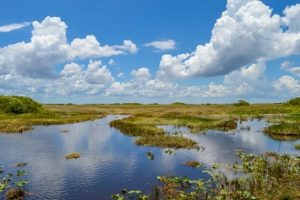May is American Wetlands Month. With President Donald Trump’s promise to repeal, or at the very least revise, the Clean Water Rule with its definition of Waters of the United States (WOTUS) that was established during the Obama administration, the U.S. Environmental Protection Agency (EPA) is mired in controversy over the extent of federal responsibility regarding protection of wetlands. The EPA is planning a handoff to states for regulatory and enforcement programs, but states want money for developing and implementing wetlands programs. Today we will look at some recent wetlands enforcement actions and state activity regarding wetlands. Tomorrow we will offer some tips for recognizing a wetland as the first step in determining if you need a permit.

HonestTraveller / iStock / Getty Images Plus / Getty Images
Tip: No matter what happens with the definition of “Waters of the United States,” anyone undertaking a project that would possibly impact a wetland may need a permit.
Permit Denied—By a State!
The regulation of wetlands in the United States involves a variety of regulatory schemes, including the Section 404 regulation for the discharge of dredged or fill material into WOTUS under the federal Clean Water Act (CWA).
Section 401 of the CWA requires state certification that a federal permit meets state water quality standards as a condition of the federal permit approval. In most cases, the state environmental agency administers water quality certification. An individual permit applicant for the Section 404 permit is required to first obtain state certification that any proposed discharge will comply with applicable effluent limitations and water quality standards under Section 401 of the CWA.
States also have a role in Section 404 decisions through state programmatic general permits, water quality certification, or program assumption.
The New York State Department of Environmental Conservation (DEC) recently denied a permit for a proposed pipeline project because of, in part, its failure to avoid adverse impacts on wetlands.
Expensive Dredging
Despite the Trump administration’s industry-friendly stance, there have been at least two expensive wetlands enforcement actions so far this year by the EPA. In Oregon, Martin Nygaard and Nygaard Land, LLC, must take on a major wetland restoration effort, covering 72 acres of a formerly wooded property owned and cleared by Nygaard. The project is part of a federal settlement between the EPA and Nygaard and his company to resolve CWA discharge violations on the property. The alleged violations include discharging dredged or fill material into wetlands and other WOTUS without an Army Corps of Engineers (Corps) CWA Section 404 permit. In addition to the restoration project and stream bank repairs, Nygaard will pay a $62,924 penalty.
In another case, the owners and operators of the Pikewood National Golf Club in Morgantown, West Virginia, will restore 6,400 linear feet of stream at the golf course and complete substantial additional wetlands mitigation work on property at or near the golf course. The companies involved will also pay a $1.8 million penalty.
ECOS: Show Us the Money
To date, only two states have assumed management of the Section 404 wetlands permitting program, but most states have enacted laws that preserve, protect, and conserve the state’s freshwater wetlands, tidal wetlands, coastal areas, and other protected waters of the state. State regulations are often more stringent than the federal, as they can include areas adjacent to wetlands to provide a buffer zone.
The Trump administration and EPA Administrator Scott Pruitt make no secret that they want states to be the primary enforcers of environmental laws and regulations. In addition, the president’s proposed budget would significantly reduce state and tribal government Wetlands Development grants.
According to the Environmental Council of States (ECOS), states and tribes remain reluctant to assume the 404 program because of the lack of clarity on criteria used to identify waters subject to wetlands regulation and the fact that states that assume the federal Section 404 permitting program are prohibited from receiving federal funding for implementation. The money available is for the development of programs only, and that itself is facing a major reduction.
To address this lack of clarity and funding, the ECOS recently passed a resolution calling on the EPA and the Corps to work with states to provide clarity on the identification of waters subject to regulation. The ECOS also requested that Congress provide adequate funding for states that assume the Section 404 permitting program and to broaden the eligibility of the existing EPA wetland grant program for both development and implementation activities.
Unsure if your project needs a wetlands permit? Check tomorrow’s Advisor for some tips for recognizing a wetland—the first step in determining whether you need a permit.
